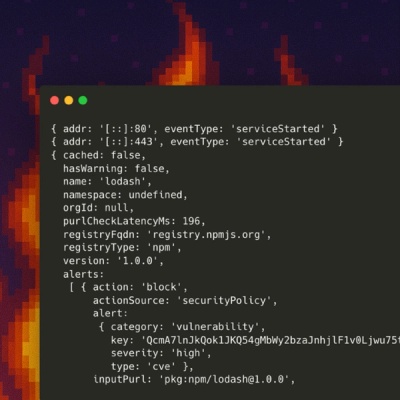
Research
/Security News
10 npm Typosquatted Packages Deploy Multi-Stage Credential Harvester
Socket researchers found 10 typosquatted npm packages that auto-run on install, show fake CAPTCHAs, fingerprint by IP, and deploy a credential stealer.
fluid-js is a library that generates audio data (frames). fluid-js uses wasm version of FluidSynth.
npm install --save fluid-js
Copies dist/fluid.js (or dist/fluid.min.js) and externals/libfluidsynth-2.0.2.js (libfluidsynth JS file) to your project, and writes <script> tags as following order:
<script src="libfluidsynth-2.0.2.js"></script>
<script src="fluid.js"></script>
When scripts are available, you can use APIs via Fluid namespace object.
// Prepare the AudioContext instance
var context = new AudioContext();
var synth = new Fluid.Synthesizer();
synth.init(context.sampleRate);
// Create AudioNode (ScriptProcessorNode) to output audio data
var node = synth.createAudioNode(context, 8192); // 8192 is the frame count of buffer
node.connect(context.destination);
// Load your SoundFont data (sfontBuffer: ArrayBuffer)
synth.loadSFont(sfontBuffer).then(function () {
// Load your SMF file data (smfBuffer: ArrayBuffer)
return synth.addSMFDataToPlayer(smfBuffer);
}).then(function () {
// Play the loaded SMF data
return synth.playPlayer();
}).then(function () {
// Wait for finishing playing
return synth.waitForPlayerStopped();
}).then(function () {
// Wait for all voices stopped
return synth.waitForVoicesStopped();
}).then(function () {
// Releases the synthesizer
synth.close();
}, function (err) {
console.log('Failed:', err);
// Releases the synthesizer
synth.close();
});
(Above example uses Web Audio API, but you can use Synthesizer without Web Audio, by using render() method.)
If you prefer to load fluid-js as an ES module, you can use import statement such as import * as Fluid from 'fluid-js'.
Notes:
fluid.js intends the ES2015-supported environment. If you need to run the script without errors on non-ES2015 environment such as IE11 (to notify 'unsupported'), you should load those scripts dynamically, or use transpiler such as babel.Fluid.waitForReady.import-able and its license (LGPL v2.1) is differ from fluid-js's (BSD-3-Clause).fluid-js supports AudioWorklet process via dist/fluid.worklet.js (or dist/fluid.worklet.min.js). You can load fluid-js on the AudioWorklet as the following code:
var context = new AudioContext();
context.audioWorklet.addModule('libfluidsynth-2.0.2.js')
.then(function () {
return context.audioWorklet.addModule('fluid.worklet.js');
})
.then(function () {
// Create the synthesizer instance for AudioWorkletNode
var synth = new Fluid.AudioWorkletNodeSynthesizer();
synth.init(context.sampleRate);
// You must create AudioWorkletNode before using other methods
// (This is because the message port is not available until the
// AudioWorkletNode is created)
audioNode = synth.createAudioNode(context);
audioNode.connect(context.destination); // or another node...
// After node creation, you can use Synthesizer methods
return synth.loadSFont(sfontBuffer).then(function () {
return synth.addSMFDataToPlayer(smfBuffer);
}).then(function () {
return synth.playPlayer();
}).then(function () {
...
});
});
fluid-js and libfluidsynth can be executed on a Web Worker. Executing on a Web Worker prevents from blocking main thread while rendering.
To use fluid-js on a Web Worker, simply call importScripts as followings:
self.importScripts('libfluidsynth-2.0.2.js');
self.importScripts('fluid.js');
(You can also load fluid-js as an ES Module from the Web Worker.)
Note that since the Web Audio is not supported on the Web Worker, the APIs/methods related to the Web Audio will not work. If you want to use both Web Worker and AudioWorklet, you should implement AudioWorkletProcessor manually as followings:
MessageChannel and sending its port instances to Web Worker and AudioWorklet, they can communicate each other directly.process methodThese classes implement the interface named Fluid.ISynthesizer.
Fluid.Synthesizer (construct: new Fluid.Synthesizer())
Fluid.AudioWorkletNodeSynthesizer (construct: new Fluid.AudioWorkletNodeSynthesizer())
createAudioNode method to use other instance methods.The Sequencer instance is created only via following methods:
Fluid.Synthesizer.createSequencer (static method)
Fluid.ISequencer instance. The instance can be used with Fluid.Synthesizer instances.Fluid.AudioWorkletNodeSynthesizer.prototype.createSequencer (instance method)
Fluid.ISequencer instance. The instance can be used with Fluid.AudioWorkletNodeSynthesizer instances which handled createSequencer calls.NOTE: libfluidsynth-2.0.2.js (or above) is necessary to use this feature.
From v1.2.0, you can hook MIDI events posted by player. For Fluid.Synthesizer instance, use hookPlayerMIDIEvents method as followings:
syn.hookPlayerMIDIEvents(function (s, type, event) {
// hook '0xC0' event (Program Change event)
if (type === 0xC0) {
// if the 'program' value is 0, use another SoundFont
if (event.getProgram() === 0) {
syn.midiProgramSelect(event.getChannel(), secondSFont, 0, 0);
return true;
}
}
// return false to use default processings for other events
return false;
});
For Fluid.AudioWorkletNodeSynthesizer instance, use hookPlayerMIDIEventsByName as followings:
// We must add method to AudioWorkletGlobalScope to pass to another module.
AudioWorkletGlobalScope.myHookPlayerEvents = function (s, type, event, data) {
if (type === 0xC0) {
if (event.getProgram() === 0) {
// 'secondSFont' will be passed from 'hookPlayerMIDIEventsByName'
s.midiProgramSelect(event.getChannel(), data.secondSFont, 0, 0);
return true;
}
}
return false;
};
// before use this, 'worklet.js' above must be loaded as AudioWorklet completely, and
// syn.createAudioNode must be called to activate worklet.
// The first parameter is the method name added to 'AudioWorkletGlobalScope'.
// The second parameter will be passed to the worklet.
syn.hookPlayerMIDIEventsByName('myHookPlayerEvents', { secondSFont: secondSFont });
The sequencer also supports 'user-defined client' to handle event data.
Synthesizer.createSequencer, use Synthesizer.registerSequencerClient static method.
Synthesizer.sendEventNow static method to event data processed by the synthesizer or another clients.createSequencer of AudioWorkletNodeSynthesizer, use registerSequencerClientByName instance method.
hookPlayerMIDIEventsByName's callback.Synthesizer.sendEventNow in the worklet. Synthesizer constructor is available via AudioWorkletGlobalScope.Fluid.Synthesizer.Fluid.rewriteEventData (AudioWorkletGlobalScope.Fluid.rewriteEventData for worklet).Fluid methodswaitForReadyCan be used to wait for the synthesizer engine's ready.
Return: Promise object (resolves when the synthesizer engine (libfluidsynth) is ready)
Fluid.ISynthesizer methods(Not documented yet. Please see dist/lib/ISynthesizer.d.ts.)
fluid-js is licensed under BSD 3-Clause License except for the files in externals directory.
For licenses of the files in externals directory, please read externals/README.md.
v1.2.0
FAQs
Wrapper JS library of fluidsynth for using with Web Audio or etc.
We found that fluid-js demonstrated a not healthy version release cadence and project activity because the last version was released a year ago. It has 1 open source maintainer collaborating on the project.
Did you know?

Socket for GitHub automatically highlights issues in each pull request and monitors the health of all your open source dependencies. Discover the contents of your packages and block harmful activity before you install or update your dependencies.

Research
/Security News
Socket researchers found 10 typosquatted npm packages that auto-run on install, show fake CAPTCHAs, fingerprint by IP, and deploy a credential stealer.

Product
Socket Firewall Enterprise is now available with flexible deployment, configurable policies, and expanded language support.

Security News
Open source dashboard CNAPulse tracks CVE Numbering Authorities’ publishing activity, highlighting trends and transparency across the CVE ecosystem.